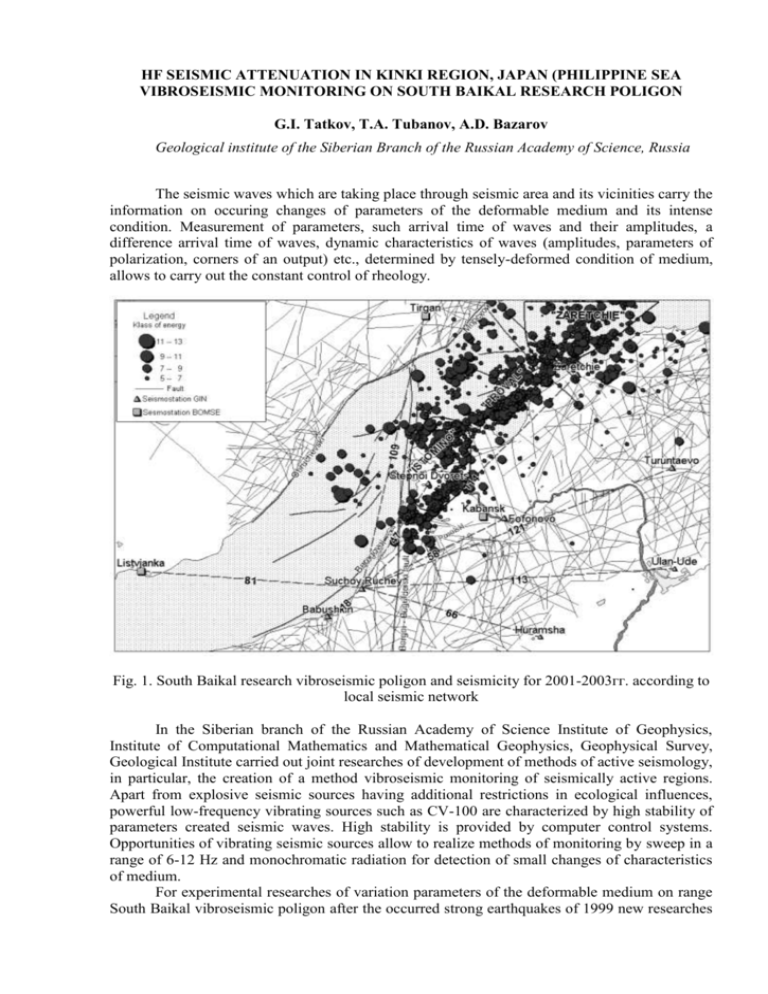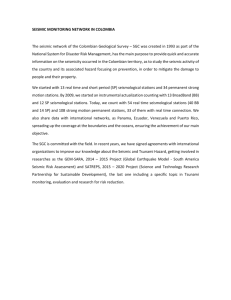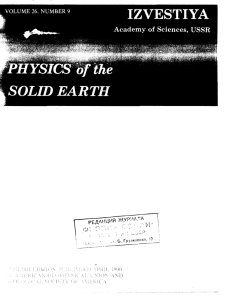GI Tatkov, TA Tubanov, AD Bazarov
advertisement

HF SEISMIC ATTENUATION IN KINKI REGION, JAPAN (PHILIPPINE SEA VIBROSEISMIC MONITORING ON SOUTH BAIKAL RESEARCH POLIGON G.I. Tatkov, T.A. Tubanov, A.D. Bazarov Geological institute of the Siberian Branch of the Russian Academy of Science, Russia The seismic waves which are taking place through seismic area and its vicinities carry the information on occuring changes of parameters of the deformable medium and its intense condition. Measurement of parameters, such arrival time of waves and their amplitudes, a difference arrival time of waves, dynamic characteristics of waves (amplitudes, parameters of polarization, corners of an output) etc., determined by tensely-deformed condition of medium, allows to carry out the constant control of rheology. Fig. 1. South Baikal research vibroseismic poligon and seismicity for 2001-2003гг. according to local seismic network In the Siberian branch of the Russian Academy of Science Institute of Geophysics, Institute of Computational Mathematics and Mathematical Geophysics, Geophysical Survey, Geological Institute carried out joint researches of development of methods of active seismology, in particular, the creation of a method vibroseismic monitoring of seismically active regions. Apart from explosive seismic sources having additional restrictions in ecological influences, powerful low-frequency vibrating sources such as CV-100 are characterized by high stability of parameters created seismic waves. High stability is provided by computer control systems. Opportunities of vibrating seismic sources allow to realize methods of monitoring by sweep in a range of 6-12 Hz and monochromatic radiation for detection of small changes of characteristics of medium. For experimental researches of variation parameters of the deformable medium on range South Baikal vibroseismic poligon after the occurred strong earthquakes of 1999 new researches were resumed with powerful vibroseismic source CV-100 located in area near town Babushkin (station «Suchoy ruchey»). The computer control systems, quartz highly stable specifying generators and GPS of exact times are established on CV-100. Installation of a new control system has improved synchronization of systems of radiation and registration and has increased the stability of radiation. Local network of observations, including 8 stations, was created, taking into consideration neotectonic structures and sites of the stationary low-frequency vibrator. The seismic stations are distanced on 58-256 kms from CV-100 and equipped with standard seismic data-logger «Baikal» and «Geon». The regional seismological stations of Pribaikalye are used also in vibromonitoring. The common area covered by vibroseismic monitoring exceeds 20000 sq. km that allows to realize technology of the multivector monitoring which controls different directions and different volumes seicmic mediums. The traces crossing the basic zones of geodynamic activity of South Baikal vibroseismic poligon: «Vibrator – Listvjanka» (South Baikal seismic area); «Vibrator – Huramsha» (Orongoy,s area); «The vibrator - Zaretchie» (Selenga area) are the most interesting for researches. Observation at stations «Tirgan», «Fofonovo», «Turuntaevo» are important for monitoring Obruchev and Primorskiy border faultes, Borgoy- Buguldeyka slip which repeatedly becoming more active in rift process. By experiments of 2000-2003 it was established, that vibrator CV-100 on South Baikal geodynamic poligon, as well as the same source in Bistrovka, has summer and winter, intermediate types of stable radiation. In conditions nonrigid summer coupling of a platform of the vibrator with medium, the maximum of a spectrum of influence is displaced in an interval multiple and fold harmonics. For convolutions of January - middle May the stable form and a parity between seismic phases is marked. On intermediate seismogram of May - June arrival time of group longitudinal Р - waves (Z-component) increase a little, and arrival time of group of cross-section S-waves, vice verso decrease. These changes arrival times of seismic phases can be caused by instability of radiation of a source in a intermediate period «winter – summer». The vibroseismic, seismological and geomagnetic results were compared for an estimation of a geodynamic component of observable velocity anomalies of longitudinal waves. It turned out that the increasing trend of times of introductions on lines «Vibrator – Turuntaevo» and «Vibrator – Tirgan» coincides with increasing of seismic issue in Selenga seismic area. Smooth changes of a gradient of a magnetic field between points «Hurumsha» and «Suchoy ruchey» are well correlated with variations of times of introductions of longitudinal waves on same line. On the separate lines located along basins of lake Baikal (the points «Talaja», «Listvjanka»), register the intensive direct wave which is taking place through the water medium with average velocity of 1500 km/s, that causes some difficulties in allocation Pg and Sg waves without special methods of processing. At station «Zaretchie» experiments with seismic array are necessary, because of a high level of microseismic noise For the further finding-out of existential variations features of high-velocity parameters it is necessary to continue regular vibroseismic sounding, to develop ways of processing of experimental data, to expand a set of measured characteristics of a stationary wave field.






